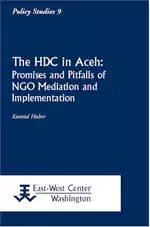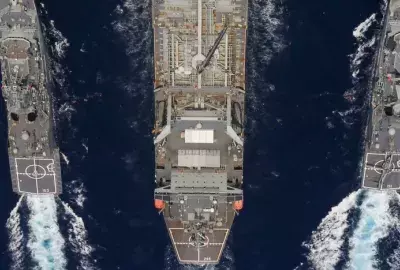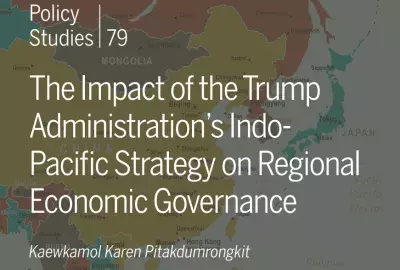Error message

This paper examines the unprecedented role played by a nongovernmental organization, the Henry Dunant Centre for Humanitarian Dialogue (HDC), in facilitating negotiations between the Indonesian government and the armed Acehnese separatist movement GAM. The negotiations led in 2000 to a cease-fire, known as the "humanitarian pause," that held fitfully into 2001. The major breakthrough, however, came in December 2002 when the parties signed the Cessation of Hostilities Agreement. This agreement, COHA, envisioned a cease-fire followed by demilitarization measures and an "all-inclusive dialogue" on autonomy provisions followed by provincial elections in Aceh. Within months, however, this agreement broke down, and Indonesian security forces launched their largest-ever military operations in the restive province. Based on extensive interviews with participants in the negotiation process, this analysis tries to understand what caused the breakdown by looking at the strengths and weaknesses of a nongovernmental institution like HDC in facilitating, mediating, and then attempting to guide implementation of complex, risk-prone accords between battle-hardened adversaries.
This paper first reviews the growing literature on third parties in mediating internal conflicts, not just during the negotiations leading to an accord but also in the all-important phase of "peace implementation" once a pact has been signed. Before and during the negotiation process, mediators rely on varying approaches and different sources of influence to reconcile parties. Once a peace deal has been concluded, one of the major challenges of implementation is to deal with "spoiler" parties either inside or outside the negotiation process that seek to undermine a nascent accord for partisan gain or even to block any agreement out of a deeper opposition to peace. A particular concern, therefore, is the political authority invested in the third party charged with guaranteeing implementation of an accord. In contrast with nongovernmental organizations like HDC, states acting individually or collectively through an inter-governmental body like the United Nations (UN) or a regional forum arguably have important advantages in mediating and then safeguarding accords in armed disputes.
A brand-new organization, HDC was nonetheless able to gain entry into the long-running conflict between GAM rebels and the Indonesian state and bring about significant agreements between the belligerents early 2000 and late 2002. Over time HDC increasingly reached out to key states, including Norway, the US, and others, to secure financial support and political backing for its dialogue efforts. In an effort to make broader interest in a successful peace deal more visible and to lend technical expertise to the dialogue process, HDC constituted a group of "wise men," international experts possessing considerable political stature and clear linkages to important countries. Also, learning from its vexed experience in monitoring the short-lived humanitarian pause from mid-2000 till early 2001, HDC proposed a more ambitious third-party guarantor—the Joint Security Committee—which would guide implementation of the December 2002 COHA through the presence of military observers from nearby Thailand and Philippines. The design and functioning of the JSC, however, proved insufficient to stave off spoiling by GAM and the Indonesia military, which ultimately scuttled the COHA in March-April 2003.
Three major themes emerge from the examination of HDC's role in Aceh. First, political dynamics within and around Indonesia shifted significantly between late 1999 and early 2002. It is not clear that the conflict, even if "ripe" at the start of this period, was still truly amenable for resolution in the face of intransigence from GAM and the Indonesian military on key issues. Second, HDC was repeatedly confronted with the limits to what a nongovernmental organization lacking formal power could do to ensure a successful accord. For example, HDC recognized in the run-up to the COHA that a more substantial third-party role, ideally led by a state, would be necessary for successful peace implementation. In the wake of the East Timor crisis, however, Jakarta opposed any formal role for an international organization, and donor countries side-stepped direct responsibility for implementing the peace process, leaving the task to HDC (and the JSC) without sufficient political authority.
Finally, HDC's experience reveals a number of issues that the organization chose not to address but that can provide important support for similar peace efforts elsewhere. In addition to devising an effective third party for peace implementation, these issues include: (1) developing analytical capacity and organizational learning, (2) identifying, framing, and sequencing the issues for negotiation, (3) dealing with problems of representation and coherence within the parties, (4) working with civil society, (5) managing the pace of the negotiation process, and (6) harnessing international support. For example, on the second issue—the sequencing of negotiation—it is pertinent to ask whether a ceasefire followed by a process for political settlement is sufficiently stable to yield peace. It is also opportune to question whether a non-state organization is properly endowed for international mediation in a separatist conflict like Aceh's.

This paper examines the unprecedented role played by a nongovernmental organization, the Henry Dunant Centre for Humanitarian Dialogue (HDC), in facilitating negotiations between the Indonesian government and the armed Acehnese separatist movement GAM. The negotiations led in 2000 to a cease-fire, known as the "humanitarian pause," that held fitfully into 2001. The major breakthrough, however, came in December 2002 when the parties signed the Cessation of Hostilities Agreement. This agreement, COHA, envisioned a cease-fire followed by demilitarization measures and an "all-inclusive dialogue" on autonomy provisions followed by provincial elections in Aceh. Within months, however, this agreement broke down, and Indonesian security forces launched their largest-ever military operations in the restive province. Based on extensive interviews with participants in the negotiation process, this analysis tries to understand what caused the breakdown by looking at the strengths and weaknesses of a nongovernmental institution like HDC in facilitating, mediating, and then attempting to guide implementation of complex, risk-prone accords between battle-hardened adversaries.
This paper first reviews the growing literature on third parties in mediating internal conflicts, not just during the negotiations leading to an accord but also in the all-important phase of "peace implementation" once a pact has been signed. Before and during the negotiation process, mediators rely on varying approaches and different sources of influence to reconcile parties. Once a peace deal has been concluded, one of the major challenges of implementation is to deal with "spoiler" parties either inside or outside the negotiation process that seek to undermine a nascent accord for partisan gain or even to block any agreement out of a deeper opposition to peace. A particular concern, therefore, is the political authority invested in the third party charged with guaranteeing implementation of an accord. In contrast with nongovernmental organizations like HDC, states acting individually or collectively through an inter-governmental body like the United Nations (UN) or a regional forum arguably have important advantages in mediating and then safeguarding accords in armed disputes.
A brand-new organization, HDC was nonetheless able to gain entry into the long-running conflict between GAM rebels and the Indonesian state and bring about significant agreements between the belligerents early 2000 and late 2002. Over time HDC increasingly reached out to key states, including Norway, the US, and others, to secure financial support and political backing for its dialogue efforts. In an effort to make broader interest in a successful peace deal more visible and to lend technical expertise to the dialogue process, HDC constituted a group of "wise men," international experts possessing considerable political stature and clear linkages to important countries. Also, learning from its vexed experience in monitoring the short-lived humanitarian pause from mid-2000 till early 2001, HDC proposed a more ambitious third-party guarantor—the Joint Security Committee—which would guide implementation of the December 2002 COHA through the presence of military observers from nearby Thailand and Philippines. The design and functioning of the JSC, however, proved insufficient to stave off spoiling by GAM and the Indonesia military, which ultimately scuttled the COHA in March-April 2003.
Three major themes emerge from the examination of HDC's role in Aceh. First, political dynamics within and around Indonesia shifted significantly between late 1999 and early 2002. It is not clear that the conflict, even if "ripe" at the start of this period, was still truly amenable for resolution in the face of intransigence from GAM and the Indonesian military on key issues. Second, HDC was repeatedly confronted with the limits to what a nongovernmental organization lacking formal power could do to ensure a successful accord. For example, HDC recognized in the run-up to the COHA that a more substantial third-party role, ideally led by a state, would be necessary for successful peace implementation. In the wake of the East Timor crisis, however, Jakarta opposed any formal role for an international organization, and donor countries side-stepped direct responsibility for implementing the peace process, leaving the task to HDC (and the JSC) without sufficient political authority.
Finally, HDC's experience reveals a number of issues that the organization chose not to address but that can provide important support for similar peace efforts elsewhere. In addition to devising an effective third party for peace implementation, these issues include: (1) developing analytical capacity and organizational learning, (2) identifying, framing, and sequencing the issues for negotiation, (3) dealing with problems of representation and coherence within the parties, (4) working with civil society, (5) managing the pace of the negotiation process, and (6) harnessing international support. For example, on the second issue—the sequencing of negotiation—it is pertinent to ask whether a ceasefire followed by a process for political settlement is sufficiently stable to yield peace. It is also opportune to question whether a non-state organization is properly endowed for international mediation in a separatist conflict like Aceh's.








